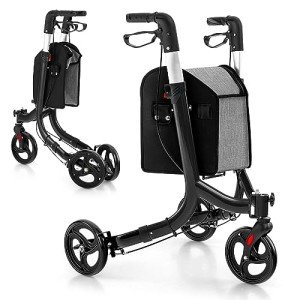What’s The Current Job Market For Handicap Walker Professionals Like?
Understanding Handicap Walkers: Types, Benefits, and Usage
Handicap walkers, likewise commonly called mobility walkers or simply walkers, function as essential aids for people with mobility challenges. These devices offer physical support and stability, making it possible for users to walk more with confidence and individually. This post digs into the numerous kinds of handicap walkers, their benefits, and important factors to consider when picking one.
What is a Handicap Walker?
A handicap walker is a gadget developed to help individuals who have trouble walking due to age, health problem, or special needs. Walkers help users preserve their balance, prevent falls, and recover mobility. Unlike canes, which supply very little support, handicap walkers typically use a wider base of stability, making them suitable for more significant mobility difficulties.
Types of Handicap Walkers
Handicap walkers can be found in different styles, designed to meet the unique needs of users. Below is a breakdown of the most typical types:
| Type of Walker | Description | Ideal User |
|---|---|---|
| Standard Walker | A lightweight frame that requires lifting to move. Normally has rubber suggestions for traction. | Those who can lift the walker and have moderate balance problems. |
| Wheeled Walker | Features two wheels at the front, permitting simpler mobility without lifting. | Users who can keep stability and need more support while walking. |
| Rollator Walker | Similar to wheeled walkers however includes hand brakes and a seat for resting. | Individuals needing a portable resting option with improved mobility. |
| Bariatric Walker | Particularly designed for much heavier individuals, offering strengthened frames and larger hand grips. | Much heavier users requiring additional assistance and stability. |
| Child Walker | Personalized models for kids to aid in their advancement and mobility. | Kids with developmental delays or mobility obstacles. |
Benefits of Using a Handicap Walker
Numerous users discover that handicap walkers significantly improve their lifestyle. Here are some benefits:
1. Increased Stability
Handicap walkers supply a sturdy assistance structure, which assists avoid falls and increases users’ self-confidence when walking around.
2. Boosted Mobility
Walkers make it much easier for individuals with mobility restrictions to browse stairs, unequal surfaces, and other difficult environments.
3. Independence
Utilizing a walker enables individuals to carry out daily activities individually, whether it’s walking the home or going shopping.

4. Pain Relief
Walkers enhance posture and distribute weight more equally, possibly relieving pain in joints and muscles during movement.
5. Social Engagement
By assisting in mobility, walkers enable users to take part more actively in social occasions, family events, and community activities, promoting a sense of belonging.
Crucial Considerations When Choosing a Walker
Selecting the right handicap walker is vital for ensuring safety and convenience. Below are key factors to think about:
-
User’s Height: Walkers come in different heights. It’s vital to select one that permits the user to stand upright with a minor bend in the elbows when holding onto the handles.
-
Weight Capacity: Assess the weight capability of the walker, particularly for bariatric choices, to guarantee it matches the user’s requirements.
-
Portability: If the walker will be used often in different places, consider models that can be easily folded or transferred, such as rollators.
-
Features: Some walkers include extra functions like cushioned seats, storage baskets, and adjustable handles. Assess which functions are most helpful for the user.
-
User Preferences: The individual’s convenience and choices must also play a significant function in the choice. Evaluating various models might help figure out the best fit.
How to Use a Handicap Walker Effectively
Utilizing a Handicap Walker (similar resource site) correctly makes sure safety and maximizes its benefits. Follow these actions for safe use:
- Adjust the Height: Make sure the walker is adapted to the correct height for the user.
- Support the Walker: Place the walker in front while ensuring all four rubber pointers or wheels touch with the ground.
- Use Proper Techniques: Move the walker forward about one step length, and then enter the walker while keeping the weight balanced.
- Maintain Good Posture: Stand straight and make use of the walker for assistance, not leaning exceedingly on it.
- Practice Regularly: Encourage users to practice walking with the walker routinely, assisting to construct confidence and improve balance.
Regularly Asked Questions (FAQs)
1. What is the difference between a standard walker and a rollator?
Standard walkers require the user to raise them with each step, while rollators have wheels and enable the user to press them forward without lifting. Rollators likewise generally include brakes and may have a seat.
2. Are handicap walkers covered by insurance coverage?
Coverage for handicap walkers can differ based upon a person’s insurance plan. It is recommended to talk to the company for specific information relating to coverage and any essential documents needed.
3. Can kids use handicap walkers?
Yes, there are walkers developed specifically for kids that deal with their developmental needs. It’s vital to pick a design that is age-appropriate and offers the needed support.
4. How do I preserve my walker?
Routinely check the walker for wear and tear, consisting of the grips and wheels. Clean the walker as needed and ensure all parts are working properly for safety.
5. When is it time to stop using a walker?
This varies by individual. Users need to seek advice from their doctor to evaluate mobility improvements and go over whether transitioning to a different mobility aid or moving without support is appropriate.
A handicap walker can be a transformative tool for people with mobility challenges, offering them higher stability, independence, and boosted quality of life. By comprehending the different types, benefits, and crucial considerations in selecting a walker, people can make informed options that line up with their unique requirements and way of life. Whether for rehab, aging gracefully, or managing impairments, handicap walkers play an important function in promoting mobility and well-being.

